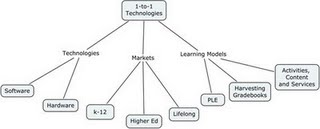Category — Mod07: One-to-one Technologies
Module 7 One to One Technologies CONCLUSION
To view our concluding statements and a great summative concept map, please come to the CONCLUSION TAB of our NING website.
Thank you all for participating in the discussion forums this week. There was excellent dialogue generated among class members.
Thanks again.
The Module 7 team.
November 1, 2009 6 Comments
Improving the Ratio
First off, thank you Module 7 for this presentation, it’s got me thinking in some new directions.
I was thinking through some of the issues with moving towards a 1:1 ratio, many of which are being discussed in the forums and comments, and looking for inexpensive ways of deploying more computers for students to use. I have better than a 1:1 ratio in my class, but my school at large is nowhere near. Here are two technologies that I’ve found, and I’m hoping that together we can find more.
Linux Terminal Server Project (http://www.ltsp.org/)
Linux Terminal Server Project (LTSP) is designed to connect multiple low-cost terminals to a powerful server which does all of the processing and storage for all users. The terminals can be old computers or newer thin clients, as long as they have a basic processor, video card, network card, and keyboard and mouse support. They don’t need any drives, as storage is handled by the server. Input by users is sent over the network, the server does the processing, and the results are resent over the network for the terminal to display. Practically, it’s like having your own machine.
The advantage to this is in costs and maintenance. The server is the only machine that needs to be setup and maintained. All of the terminals are interchangeable, and with the drives removed, the most common failures are gone as well. A single quad-core machine acting as a server (about $700) should run about 30 clients at reasonable speed. If the terminals are powerful enough, some processing can be done on them to reduce the load on the server too. Just about any old computer can be a terminal, so the clients can be old inventory or donated machines. Ubuntu includes a LTSP configuration in the install disk, so setting up a basic lab can be done in just a few hours.
The issue with this setup is that it uses Linux. While the OS and applications are free, it may be difficult getting IT to manage the system. If the IT already supports Linux, it should be an easy implementation.
Userful (http://www2.userful.com/)
From what I can tell, Userful behaves similarly to an LTSP environment, but instead of dummy boxes connected by network to the server, a keyboard, mouse, and monitor is connected directly to the server. It also uses Linux as the OS, so the same implications with software as the LTSP apply.
There are some performance advantages to this setup. Since each monitor/desktop has direct access to a video card, video performance is improved. Also, since a server is limited to about 10 user desktops, each user could have a larger slice of the processing power. The company claims that it costs about $70 per user in hardware costs in addition to the server. Here’s my own cost estimate for a brand new lab of 30 machines. You would need 30 modules ($2100), 3 servers ($2100), 15 video cards ($900), 30 keyboards, mice, and monitors ($6000), which comes to $11100. I imagine that many schools would be able to scrounge the keyboards, mice and monitors, and that would reduce the cost significantly, to just over $5000.
If you know of other options, I’d love to see more solutions for schools looking to expand their computer offerings.
October 30, 2009 6 Comments
Education World ® Technology Center: One-to-One Computing
Please view the article (link below):
Is your school ready for one to one computing?
Handhelds, laptops, tablet PCs…Which is best for your school? Guest columnist Elizabeth Sky-McIlvain offers a simple rubric for administrators, teachers, and parents to use when evaluating their school’s readiness for one-to-one computing. Print this rubric and share it with your entire school community.
Education World ® Technology Center: One-to-One Computing.
Join in the discussion at our Module 7 NING site:

October 27, 2009 8 Comments
Module 7 feed link
October 26, 2009 No Comments
Module 7 One to One Technologies
Welcome!
Please begin by looking at this concept map to get a sense of the content we covered in this module. This initial concept map serves as a Module organizer only. Check back at the end of this week to see a more interactive concept map that you can use for summative review.

To start off the dialogue, we would like you to consider the following question FIRST and post your replies here, before proceeding to our NING site.
When you hear the term “One to One Technologies” what does it mean to you?
Once you have responded to the above question, please proceed to our Module 7 website:
There are instructions on the main page for navigating through the site.
You should be able to SIGN IN using the same email / password that you have used before, for NING.
There are many opportunities for you to engage in dialogue and discussion.
We will also provide an RSS feed so you can follow the discussion here.
Check back here throughout the week to view any posts that pertain to Module 7.
And feel free to post any comments or questions here as well.
Thank you and we hope you enjoy our presentation.
Kathleen Cavanagh, Cathy Jung, Merv LaBrash, Brian Powell, and Erica Toombs
We have also provided a video showing you how to navigate through our Module 7 NING presentation:

October 25, 2009 30 Comments
